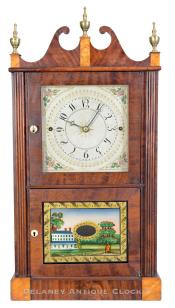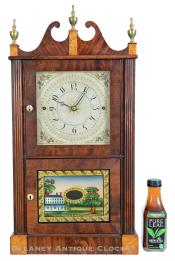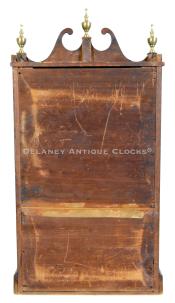A Miniature Double Door Reeded Flat Column and Scroll Top Clock made by Norris North & Company in Torrington, Connecticut. This is one of the more colorful examples I have seen. 224069.
Wooden geared mantel clocks do not come much prettier than this example. The mahogany veneered case features wonderfully grained selections of wood, bird’s-eye maple panels, reeded side columns, and a classic arched pediment. The five bird’s-eye maple veneered panels are strategically positioned in the case design. Two are featured in the design of the base. The other three are used to support the shaped horns and also as finial plinths. The contrast between the darker mahogany and the honey-colored maple is excellent.
This case features two doors. The upper door is fitted with glass that protects the dial. The lower door features a colorfully painted country scene, a popular theme for clocks made in Connecticut during the second quarter of the 1800s. A three-story building, most likely an Inn, is depicted on the left. A framed oval in the center features a clear opening to view the brass-faced pendulum bob. The gilt border is well done. This tablet has been professionally restored.
The wooden dial is decorated with a complex design. The floral-themed spandrels are framed in gilt work raised on applied gesso dots. The time ring is framed with a beaded border. One bead for each minute. Inside this are decorative gilt work, an additional minute ring in black beads with gilt stars at the five-minute markers, and Arabic hour numerals. A gilt star pattern radiates from the center hole. Open diamond hands depict the time.
The movement was made by Norris North and is categorized as an “East / West” movement. It is constructed from wood, has wooden gearing, and is designed to run for 30 hours on a full wind. It is a two-train design. Two cast iron weights drive the mechanism. It will strike each hour on the hour on a cast iron bell mounted below the works. The striking system is a count-wheel design.
Pasted on the backboard is the clockmaker’s label. It includes the clock’s setup and operation directions. The label also states “PATENT /IMPROVED / CLOCK. / MADE AND SOLD BY / NORRIS NORTH & CO. / TORRINGTON, Conn. / AND WARRANTED, / if well used.”
This clock was made circa 1824.
Case dimensions: The height to the top of the brass finial is 26.5 inches, and the top of the horns is 24.75 inches, 13.75 wide, and four inches deep.
Inventory number 224066.
It is speculated that Norris North was born in Goshen in 1790. His parents were Dr. Joseph North and Abigail (Loomis) North. Noris had a brother, Ethel, born in 1800, who also made clocks. In 1812, he married Lurian Grilley of Waterbury. In 1813, he enlisted in the Connecticut State Guard and served two tours in the War of 1812 when the British Navy threatened New London and New Haven.
Norris’ first shop was in Waterbury by 1820. It was a short distance from Eli Terry’s Ireland Factory, where he may have learned clockmaking.
Norris was one of the first to circumvent Terry’s patents. Instead of arranging his movements vertically, North laid out his design horizontally in an East / West fashion. Today, these movements are identified as East/West movements.
His earliest clocks were made in Waterbury and featured a four-arbor setup. It appears that sometime after 1822, he moved to Torrington and changed the setup to five arbors. Other Torrington Makers copied this layout arrangement.
In Torrington, he sets up shop on his Father’s land along the bank of the Naugatuck River in Cotton Hollow. Norris was constantly in debt and eventually signed over his property to Erastus Hodges and Aaron Smith in 1825. Under these two, North remained in charge of Clockmaking.
A series of geographical shifts marked Norris North’s life. After leaving Torrington, he embarked on a journey that took him to various locations. In 1835, he was in Oswego, NY, and then in Mexico, NY. From 1836 to 1866, he resided in Canada, and also in Roscoe, Illinois. His final move was to Grundy Center, Iowa, in 1867, where he spent his remaining years until his death in 1875.












